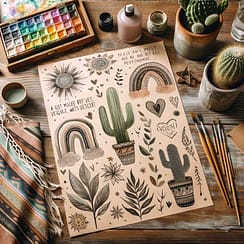
Botanical illustration is a timeless art form that marries science and art. It's not just about creating a pretty picture but also about capturing the intricate details and unique characteristics of each plant. With the rise of boho and nature-inspired designs, mastering the art of botanical illustration can be a valuable skill for any artist. Here are some techniques to help you draw flowers - they don't have to be lifelike though but they can be.
Personally I more enjoy drawing with a touch of abstract instead of reproducing the reality. But that's just me, pick what suits your needs, there is no right or wrong technique!
1. Observe and Study Real Flowers
Before you put pencil to paper, take the time to study real flowers. Understand their anatomy, how petals overlap, the way leaves curl, and the play of light and shadow. Observing from real life gives you insights that photos can't.
2. Begin with Basic Shapes
Every flower (like anything else you want to draw) can be broken down into basic geometric shapes. Whether it's a circle for the flower's center or ovals for its petals, starting with these shapes ensures your illustration has a solid foundation.

And, maybe, you don't want to be as realistic as possible? That's also fine! Don't stress yourself with realism - abstract flowers and leaves are evergreen as well!
3. Master the Art of Shading
Shading is crucial in botanical illustration. It adds depth, defines form, and brings your flower to life. Use a range of pencils, from soft leads for deep shadows to hard leads for fine details, and always consider the direction of light. Again, you don't have to. You can be as realistic as you like.
4. Use a Controlled Line
Botanical illustration demands precision. Practice drawing controlled, consistent lines. Whether you're outlining the flower or adding minute details, a steady hand is key.
5. Layer Your Colors (If Using Watercolor or Colored Pencils)
Layering is essential to achieve depth and realism. Start with a light wash or a soft layer, and gradually build up the intensity. This technique allows for more control and a richer end result. The same is valid with digital drawing techniques. Using layers and blending one layer into the other with different blending methods is also a great way to get some depth in digital painting.
6. Pay Attention to Details
The devil is in the details, especially in botanical art. From the tiny veins on a leaf to the subtle color variations in a petal, these details make your illustration stand out.
7. Practice Regularly
Like any art form, practice makes perfect. Dedicate time to sketch regularly, experiment with different techniques, and don't be afraid to make mistakes. Each attempt is a step closer to mastery.
Botanical illustration is a beautiful blend of observation, technique, and passion. By honing your skills and practicing regularly, you can capture the beauty of nature in stunning detail. Whether you're illustrating for scientific purposes, creating art for your home, or designing digital assets, these techniques will serve you well.
In this class we do draw together. I sit down and draw these leaves with you in watercolor technique. You can follow along even if you have no experience at all. As you can see these are not realistic leaves. However, you can easily recognise them as leaves.

Create and sell Watercolor Wall Art
Let's draw a watercolor artwork together and then digitise it. Once done we create different ratios and prepare it for sale. It's great fun!
